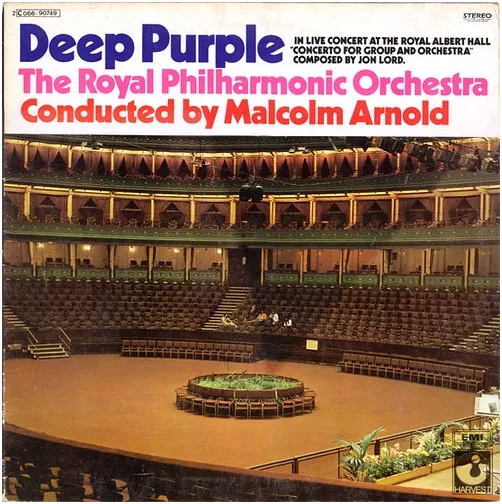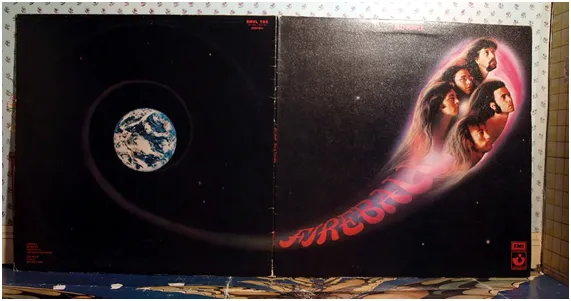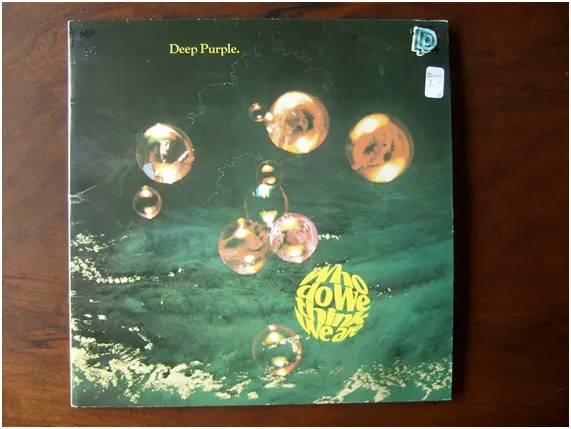
Source
The Mark II is the best incarnation of Deep Purple, highlighting the skills of Jon Lord on keyboards, the virtuosity of Ritchie Blackmore on guitar, the majestic voice of Ian Gillan and the excellent rhythmic collaboration of Roger Glover on bass and Ian Paice on drums and percussion.
On September 24, 1969, together with the Royal Philharmonic Orchestra, the first performance of this line-up took place at the Royal Albert Hall in London. This concert was released as a double live album in December of the same year. The second performance of the Concerto for Group And Orchestra took place on August 25, 1970 in the United States, at the Hollywood Bowl, accompanied by the Los Angeles Philharmonic Orchestra.

Source
In October 1969, the band enters De Lane Lea Studios and IBC to record their fourth album, Deep Purple in Rock. In the Abbey Road Studios in April 1970, the second recording session for this album was held. It is a material of excellent workmanship where themes such as Speed King and Child in Time stand out.

Source
Fireball, the band's fifth album is released in July 1971, and includes seven fantastic tracks: Strange Kind of Woman, Fireball, No no no, Demon's Eye, Anyone's Daughter, The Mule, Fools and No One Came.

The group's sixth album 'Machine Head' is recorded using the Rolling Stones' mobile recording unit between December 6 and 21, 1971 in Switzerland at the Grand Hotel in Montreux. This is an instant collector's album is considered a cornerstone in Hard Rock, released in March 1972 with tracks such as: Highway Star, Maybe I'm A Leo, Pictures of Home, Never Before, Lazy, Space Truckin and, Smoke on the Water.

Source
Already in 1972, the band was on an intense tour promoting their studio album "Machine Head". They were very tired and there were personal frictions between Ian Gillan and Ritchie Blackmore, on the other hand, Roger Glover was stressed because of the exhausting rhythm of the tour and the internal fights. It is in this environment that their managers informed the band that they had signed a tour of Japan, so the protests were not long in coming.
Nevertheless, the concerts of that tour took place on August 15 and 16 at the Festival Hall in Osaka, and on August 17 at the Nippon Budokan in Tokyo. Deep Purple developed in these concerts an extraordinary atmosphere, their music flowed and was also full of improvisations in which all the members of the band had a great rapport, these shows had an average duration of two and a half hours.
The above is captured in the mythical double live album ¨Made in Japan¨. Released in January 1973, only seven songs comprise the four sides of the album:
Higway Star (from Machine Head), opens the album with a Hammond organ that sounds spectacular courtesy of a John Lord who had nothing to envy in genius to Ritchie Blackmore. Blackmore plays a guitar solo in the second part of the song, which would later inspire Randy Rhoads or Eddie Van Halen.
Child in Time (from Deep Purple in Rock) features Ian Guillan singing in the best performance of his career on stage and is a vocally demanding gem.
Smoke on the Water (from Machine Head), features the most famous riff in Hard Rock. This song didn't hit the charts until this live version started to be played on all the radio stations. It tells the story of the fire at the Montreux Casino on December 4, 1971 during a concert of Frank Zappa where a person from the audience throws a flare on the roof of the stage and catches fire, that was the place where Deep Purple was going to start recording the next day the album Machine Head.

Source
- The Mule (from Fireball) demonstrates the virtuosity of Ian Paice on drums.

Source
Strange Kind of Woman, contains an excellent vocal-guitar duel, and demonstrates the band's ability to improvise.
Lazy (by Machine Head) stands out for Ian Gillan's harmonica, the class with which he sings, and the improvisation of John Lord and Ritchie Blackmore on keyboards and guitar respectively.
Space Truckin' (by Machine Head), stands out for its very long instrumental fragments, and inspired Steve Harris and Mike Portney in some way in their compositions for Iron Maiden and Dream Theather.
For this recording the band insisted that the sound engineer Martin Birch was their supervisor, this one achieves that in sound the Hammond Marshall organ of Jon Lord is distinguished next to the bass of Roger Glover creating an indescribable sonic wall. It seems as if Ian Gilliam and Richie Blackmore were telepathically attuned given the degree of their improvisations, and drummer Ian Paice surpasses his agility for rock rhythm.
Some say this is the greatest live album of all time, and indisputably a must-have in anyone's classic rock collection.
An anecdote still unconfirmed today indicates that at the end of the song Child in Time, in the middle of Gillan's solo on vocals, a sound very similar to a gunshot can be heard.
According to the official version that sound is produced by John Lord's keyboard during a change of the song, but another version states that the sound corresponded to a shot of a fan of the band who, ecstatic about the song, took his own life because he could not hear anything else that would overcome it. Pay attention to minute 10:02.

Who Do We Think We Are? was recorded between July and October 1972 in the cities of Rome (Italy) and Frankfurt am Main (Germany) and is Deep Purple's seventh studio album, commercially released in January 1973 in the United States and in February of the same year in the United Kingdom. It is considered a minor album, but it is very good, with interesting songs like Rat Bat Blue, Mary Long, Smooth Dancer or the critically acclaimed Woman From Tokyo. During the recording of the album Ian Gillan and Ritchie Blackmore hardly speak to each other, the atmosphere is very rarefied, they accuse Roger Glover of being a destabilizing element within the group since he is producing other musical groups and is not dedicated to work 100% with Deep Purple.

As a consequence of these problems, Ian Gillan and Roger Glover left the band, being replaced by David Coverdale and Glen Hughes respectively, thus beginning the Mark III line-up of Deep Purple.
The Mark II line-up has had two more reunions: between 1984 and 1989 (with the release of the albums: Perfect Strangers and The House Of Blue Light", respectively) and the second one that lasted only one year from 1992 to 1993, releasing the album The Battle Rages On.
Hoping to have contributed to the growth of the community, and to have made you have a good time, I bid you farewell until next time.
English is not my first language, so I use the translator DeepL.

Spanish Version

Source
La Mark II es la mejor encarnación de los Deep Purple, resalta las habilidades de Jon Lord en los teclados, el virtuosismo de Ritchie Blackmore en la guitarra, la majestuosa voz de Ian Gillan y la excelente colaboración rítmica de Roger Glover al bajo y de Ian Paice en la batería y percusión.
El 24 de septiembre de 1969 junto a la Royal Philharmonic Orchestra, se lleva a cabo la primera actuación de esta formación en el Royal Albert Hall de Londres. Este concierto fue lanzado como doble álbum en vivo en diciembre de ese mismo año. La segunda presentación del Concerto for Group And Orchestra se realiza el 25 de agosto de 1970 en Estados Unidos, en el Hollywood Bowl, acompañados de Los Angeles Philharmonic Orchestra.

Source
En octubre de 1969, la banda ingresa a los estudios De Lane Lea Studios e IBC para grabar su cuarto álbum, Deep Purple in Rock. En los estudios Abbey Road en abril de 1970 se realiza la segunda sesión de grabación de este disco. Es un material de excelente factura donde destacan temas como Speed King y Child in Time.

Source
Fireball, el quinto álbum de la banda es editado en julio de 1971, e incluye siete fantásticos temas: Strange Kind of Woman, Fireball, No no no, Demon´s Eye, Anyone’s Daughter, The Mule, Fools y No One Came.

El sexto álbum del grupo ‘Machine Head’ se registra usando la unidad móvil de grabación de los Rolling Stones entre el 6 y el 21 de diciembre de 1971 en Suiza en el Grand Hotel de Montreux. Este es un álbum de colección instantánea es considerado como una piedra angular en el Hard Rock, saliendo al mercado en marzo de 1972 con temas como: Highway Star, Maybe I´m A Leo, Pictures of Home, Never Before, Lazy, Space Truckin y, Smoke on the Water.

Source
Ya en el año 1972, el grupo realizaba una intensa gira promocionando su disco de estudio “Machine Head”. Se encontraban muy cansados existiendo roces personales entre Ian Gillan y Ritchie Blackmore, por su parte, Roger Glover estaba estresado dado el ritmo agotador de la gira y por las peleas internas. Es en este entorno que sus managers le informan a la banda que habían firmado una gira por Japón, así, las protestas no se hicieron esperar.
No obstante, los conciertos de aquella gira se celebraron el 15 y 16 de agosto en el Festival Hall de Osaka, y el 17 de agosto en el Nippon Budokan de Tokyo. Los Deep Purple desarrollaron en estos conciertos una atmosfera extraordinaria, su música fluía y además estaba llena de improvisaciones en las cuales todos sus integrantes se compenetraban, estos shows presentaban una duración promedio de dos horas y media.
Lo anteriormente expuesto queda plasmado en el mítico disco doble en directo ¨Made in Japan¨. Lanzado en enero de 1973, solo siete canciones comprenden las cuatro caras del álbum:
Higway Star (de Machine Head), abre el disco con un órgano Hammond que suena espectacular cortesía de un John Lord que nada tenía que envidiarle en genialidad a Ritchie Blackmore. Blackmore toca un solo de guitarra en la segunda parte de la canción, que más tarde inspiraría a Randy Rhoads o a Eddie Van Halen.
Child in Time (de Deep Purple in Rock) presenta un Ian Guillan cantando en la mejor actuación de su carrera encima de un escenario.Esta canción es una joya de exigencia vocal.
Smoke on the Water (de Machine Head) , presenta el riff más famoso del Hard Rock. Esta canción no llegó a las listas hasta que esta versión en directo, comenzó a sonar por todas las emisoras de radio. Nos narra la historia del incendio del Casino de Montreux el 4 de diciembre de 1971 durante un concierto de Frank Zappa donde una persona del público arroja una bengala al techo del escenario y se incendia, ese era el lugar en donde iba a empezar a grabar Deep Purple al día siguiente el álbum Machine Head.
- The Mule (de Fireball) demuestra el virtuosismo de Ian Paice en la Batería.

Source
Strange Kind of Woman, contiene un excelente duelo voz – guitarra, y demuestra la capacidad del grupo para improvisar.
Lazy (de Machine Head) destaca por la armónica de Ian Gillan, la clase con la que canta, y la improvisación de John Lord y Ritchie Blackmore en los teclados y la guitarra respectivamente.
Space Truckin´ (de Machine Head), destaca por sus larguísimos fragmentos instrumentales, e inspiró en cierta forma a Steve Harris y a Mike Portney en sus composiciones para Iron Maiden y Dream Theather.
Para esta grabación el grupo insistió que el ingeniero de sonido Martin Birch fuese su supervisor, este logra que en sonido se distinga el órgano Hammond Marshall de Jon Lord junto al bajo de Roger Glover creando una pared sónica indescriptible. Pareciese que Ian Gilliam y Richie Blackmore estuviesen sintonizados telepáticamente dado el grado de sus improvisaciones.y el baterista Ian Paice sobrepasase sus agilidad para el ritmo de rock.
Algunos dicen que este es el mejor álbum en vivo de todos los tiempos, e indiscutiblemente imprescindible en la colección de rock clásico de cualquier persona.
Who Do We Think We Are?, fue grabado entre los meses de julio y octubre de 1972 en las ciudades de Roma (Italia) y Fráncfort del Meno (Alemania) y es el séptimo disco de estudio de Deep Purple, lanzado comercialmente en enero de 1973 en Estados Unidos y en Febrero del mismo año en el Reino Unido. Es considerado un disco menor, pero es muy bueno, contando con interesantes temas como Rat Bat Blue, Mary Long, Smooth Dancer o la aclamada por la crítica Woman From Tokyo. Durante la grabación del álbum Ian Gillan y Ritchie Blackmore apenas se hablan, el ambiente está muy enrarecido, acusan a Roger Glover de ser un elemento desestabilizador dentro del grupo ya que se encuentra produciendo a otros grupos musicales y no se dedica a trabajar en un 100% con Deep Purple.

Como consecuencia de estos problemas salen del grupo Ian Gillan y Roger Glover, siendo sustituidos por David Coverdale y Glen Hughes respectivamente, dándose inicio así la formación Mark III de Deep Purple.
La formación Mark II ha tenido otras dos reuniones más: entre 1984 y 1989 (con la salida de los álbums : Perfect Strangers y The House Of Blue Light”, respectivamente) y la segunda que duró solo un año de 1992 a 1993, editando el álbum The Battle Rages On.
Esperando haber contribuido con el crecimiento de la comunidad, y haberlos hecho pasar un rato entretenido me despido hasta una próxima oportunidad.
